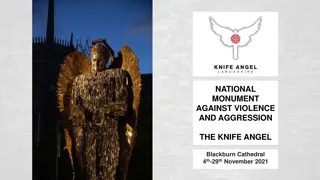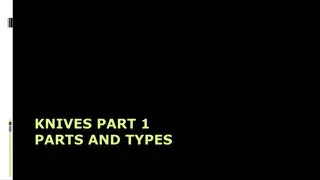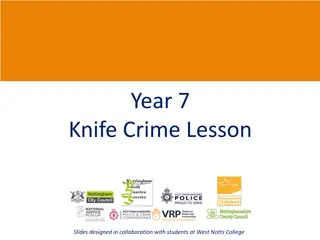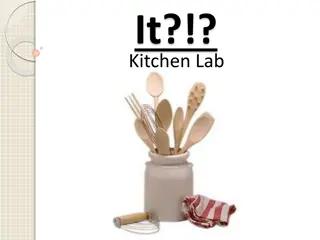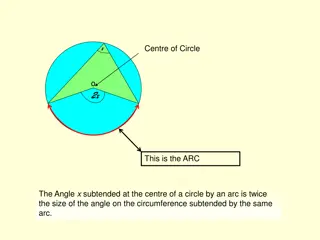Knife Safety Guidelines: The Blood Circle and Beyond
Learn essential knife safety practices such as creating a safe zone, closing and passing a knife, cutting techniques, caring for your knife, and guidelines for carrying it. Discover the importance of handling a knife responsibly to prevent accidents and maintain the blade's longevity.
Download Presentation

Please find below an Image/Link to download the presentation.
The content on the website is provided AS IS for your information and personal use only. It may not be sold, licensed, or shared on other websites without obtaining consent from the author. Download presentation by click this link. If you encounter any issues during the download, it is possible that the publisher has removed the file from their server.
E N D
Presentation Transcript
Knife Safety Basics The Blood Circle: Extend your arm with the closed knife straight in front of you. Rotate your body to either side while continuing to extend the closed knife arm. No one or thing should be in the imaginary circle that you have created. If someone enters the circle, the knife should be closed up and laid down. To Close a pocket knife: When you are not using your knife, close it and put it away. An open knife could hurt someone who doesn t realize it s there Hold handle in left hand with fingers safely on the sides. Push against the back of the blade with the heel of the right hand (sometimes easier for them to use the fingers instead of the heel) swing handle up to meet the blade. Let knife snap shut. Passing a knife: Always have the blade closed never pass an open knife. The receiver should say Thank you to indicate that they have a good grip on the knife when taking it.
Using Your Knife Always cut by pushing the knife away from you. Be sure your hands and body are out of the way. A sharp knife is safer because it s less likely to slip and cut you. A sharp knife will bite the wood. A dull knife will skip. Never throw your knife; it could easily deflect and hurt someone, or ruin the knife. Never stab anything with your knife; it will ruin your knife and possible hurt someone. When using the cutting blade, don t make big shavings or chips. Think control, not speed. Never carry an open pocketknife Always walk when carrying your knife never run with it
Caring for Your Knife How to treat your knife: A knife is a tool, not a toy. Never use your knife on something that will dull or break it (rocks, metal, cement, etc.) Never use your knife to cut living trees or plants, or poke it in the dirt. Moisture and dirt will ruin your knife. Damages the environment. Keep your knife out of the fire. The heat will ruin the temper of the steel making the knife edge soft and useless. Do not carve your initials into anything that does not belong to you Cleaning your knife: Keep your knife dry and keep the blade clean. Clean your knife by hand; the heat and steam of the dishwasher can dull and damage the knife Wipe across the blade, not on the edge. Wipe the blade with a soaked rag or a cotton ball and stick, not your fingers. Keeping our knife clean helps to keep it sharp and prevents Cleaning your knife helps to prevent cross contamination of food.
Taking Your Knife With You Many places do not allow knives. Always keep your knife at home unless your parent or Den Leader tell you otherwise. Some pack events will be designated at pocket knives allowed Most Pack 142 campfires and camping trips; leader supervision is required during these events You must earn and bring your whittling chip with you to bring your knife on these events Places where knives are prohibited even if you have your Whittling Chip card with you: School Outdoor school events (school football games) Airport Your knife and its sharpening stone are partners; where one is, the other should be also.
3 Types of Pocket Knives Jack Knife The jack knife is only hinged on one end, but it may have more than one blade. Outdoorsmen such as hunters, campers and fishermen tend to like these knifes. Pen Knife The pen knife has hinges and blades on both ends of the knife. Often, they will have two or three blades at each end. They are also smaller than the other two types. Multipurpose or Swiss Army Knife The multi-purpose knife is popular because there are so many different things they can have on them (file, scissors, tweezers, can or bottle openers and even a mini-saw blade).
Recommended Knives Blade must be 3 inches long or less A simple jack or pen knife IS recommended. It can have a locking blade or not. Locking blades are good, but depending on the knife, they be a problem for small hands to close safely. Fixed blade knives are NOT recommended because they can drop out of sheaths, or tilt and jab the wearer. Swiss army or multi-tools are NOT recommended because they are difficult for small hands to hold. Military or survival knives are NOT recommended because they can have a laser sharp edge.


